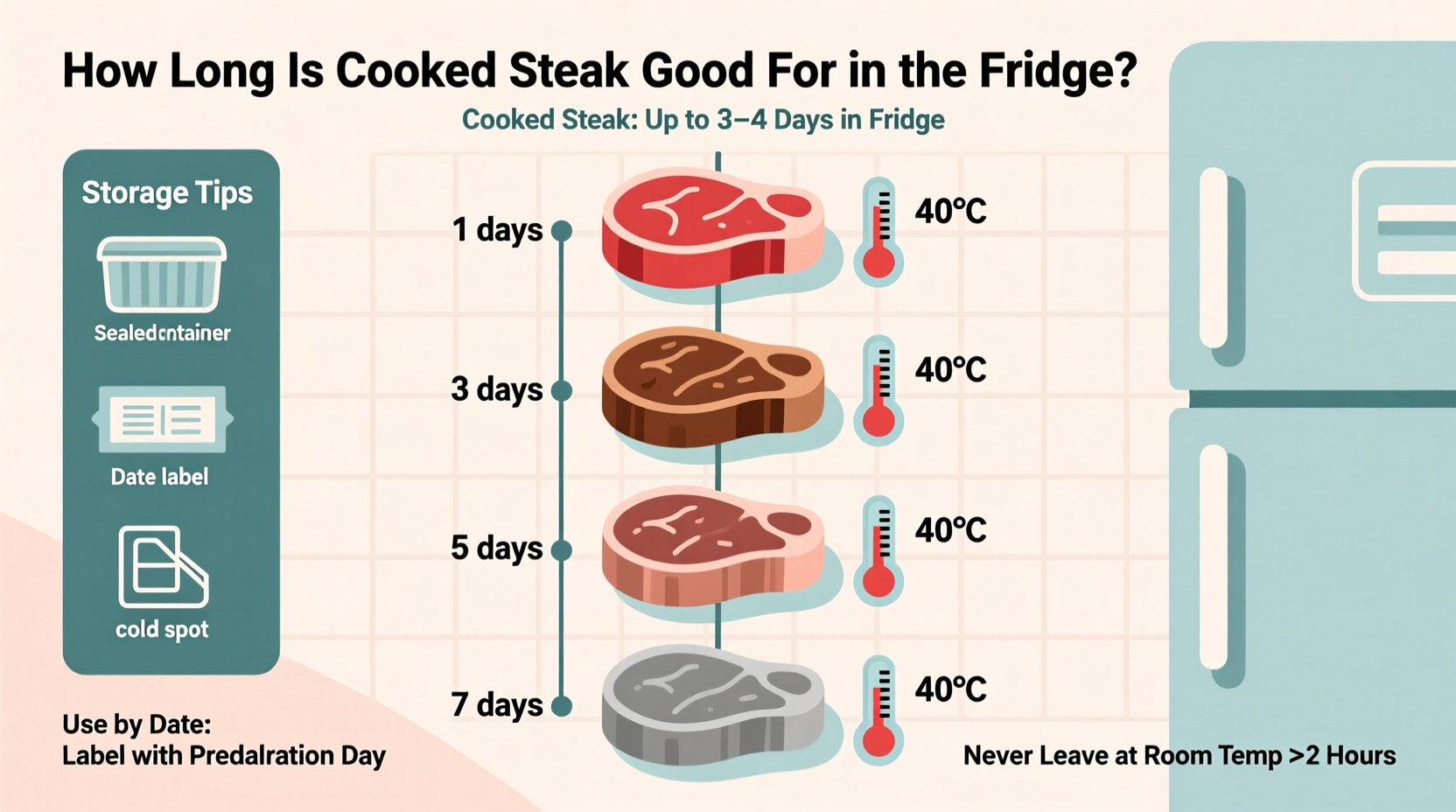Cooked steak remains safe to eat for 3-4 days when properly stored in a refrigerator set at 40°F (4°C) or below. This timeframe comes directly from the USDA Food Safety and Inspection Service, the leading authority on food safety in the United States.
Understanding exactly how long your cooked steak stays fresh isn't just about avoiding food waste—it's a critical food safety issue. Consuming steak beyond its safe storage window can lead to foodborne illnesses caused by bacteria like Salmonella, E. coli, and Listeria. Let's explore the science-backed guidelines that keep you and your family safe.
Why the 3-4 Day Rule Matters for Cooked Steak
When you cook steak, you eliminate harmful bacteria through heat. However, once the meat cools, any bacteria present in your kitchen environment can begin to multiply. The "danger zone" for food safety spans from 40°F to 140°F (4°C to 60°C), where bacteria double in number every 20 minutes under ideal conditions.
The USDA's 3-4 day recommendation isn't arbitrary—it's based on extensive research into bacterial growth rates in cooked meats. After this window, even if your steak looks and smells fine, it may contain dangerous levels of pathogens that can cause serious illness.
Maximizing Steak Freshness: Storage Best Practices
How you store your cooked steak directly impacts how long it remains safe to eat. Follow these evidence-based storage techniques:
| Storage Method | Expected Freshness | Key Benefit |
|---|---|---|
| Airtight container | 3-4 days | Prevents moisture loss and cross-contamination |
| Vacuum-sealed | Up to 10 days | Slows bacterial growth significantly |
| Wrapped in foil | 2-3 days | Better than leaving exposed, but less ideal |
| Left uncovered | 1-2 days | Rapid moisture loss and contamination risk |
Cooling Techniques That Make a Difference
How quickly you cool cooked steak before refrigerating affects its safety timeline. Never leave cooked steak at room temperature for more than two hours (or one hour if your kitchen exceeds 90°F/32°C).
Professional chefs use these cooling methods to maximize freshness:
- Slice before chilling: Cut larger steaks into smaller portions (1-2 inches thick) to cool faster
- Ice bath shortcut: Place container of hot steak in a larger bowl filled with ice water, stirring occasionally
- Shallow containers: Store in containers no deeper than 2 inches to promote even cooling

Spotting Spoiled Cooked Steak: Beyond the Clock
While the 3-4 day rule provides a safety baseline, always trust your senses before consuming any leftovers. Food safety experts recommend this multi-sensory evaluation:
Visual Inspection
Fresh cooked steak maintains its original color (though slightly darker than when first cooked). Watch for these warning signs:
- Grayish-green discoloration
- Visible mold (any color)
- Excessive liquid pooling that wasn't present initially
Smell Test Protocol
Properly stored cooked steak should have a neutral, meaty aroma. Trust your nose when you detect:
- Sour or ammonia-like odors
- Sulfur or rotten egg smells
- Any "off" smell that wasn't present when first cooked
Texture Assessment
Safe cooked steak should feel firm but moist. Discard immediately if you notice:
- Slippery or slimy surface
- Unusual stickiness
- Dry, crumbly texture beyond normal cooling effects
When in doubt, follow the food safety maxim: "When you doubt, throw it out." No meal is worth risking food poisoning.
Extending Your Steak's Safe Storage Life
If you won't consume your cooked steak within 3-4 days, freezing provides a safe alternative. The USDA confirms that frozen cooked steak remains safe indefinitely, though quality diminishes over time.
Freezing Best Practices
- Portion into single servings before freezing
- Remove as much air as possible from storage bags
- Label with contents and date
- Use within 2-3 months for best quality
Safe Thawing Methods
Never thaw frozen cooked steak at room temperature. Instead, use one of these approved methods:
- Refrigerator thawing: 24 hours for every 5 pounds (best quality)
- Cold water method: Submerge sealed package in cold water, changing water every 30 minutes
- Microwave thawing: Use defrost setting and cook immediately after thawing
Special Considerations for Different Steak Types
While the 3-4 day rule applies broadly, certain factors can shorten your steak's safe storage window:
Marinated Steaks
Acidic marinades (containing vinegar, wine, or citrus) can begin to break down proteins, potentially shortening shelf life. Consume marinated cooked steak within 3 days.
Restaurants vs. Home Cooking
Restaurant leftovers often have a shorter safe window than home-cooked steak. This happens because:
- Extended time between cooking and packaging
- Temperature fluctuations during transport
- Uncertain storage conditions before you take it home
Treat restaurant leftovers as having a 2-3 day shelf life, even if they appear fresh.
Food Safety Timeline: What Happens Each Day
Understanding the bacterial growth timeline helps explain why the 3-4 day limit exists:
- Day 0 (cooking day): Bacteria eliminated through proper cooking (145°F internal temperature)
- Day 1: Bacterial growth begins slowly as contaminants enter during handling
- Day 2-3: Bacterial colonies multiply but remain below illness-causing thresholds
- Day 4: Bacteria reach levels that can cause foodborne illness in many cases
- Day 5+: Significant risk of food poisoning even if no visible spoilage occurs
This timeline comes from research conducted by the Food and Drug Administration and USDA, documented in the FDA Food Code and USDA Food Safety Basics.











 浙公网安备
33010002000092号
浙公网安备
33010002000092号 浙B2-20120091-4
浙B2-20120091-4